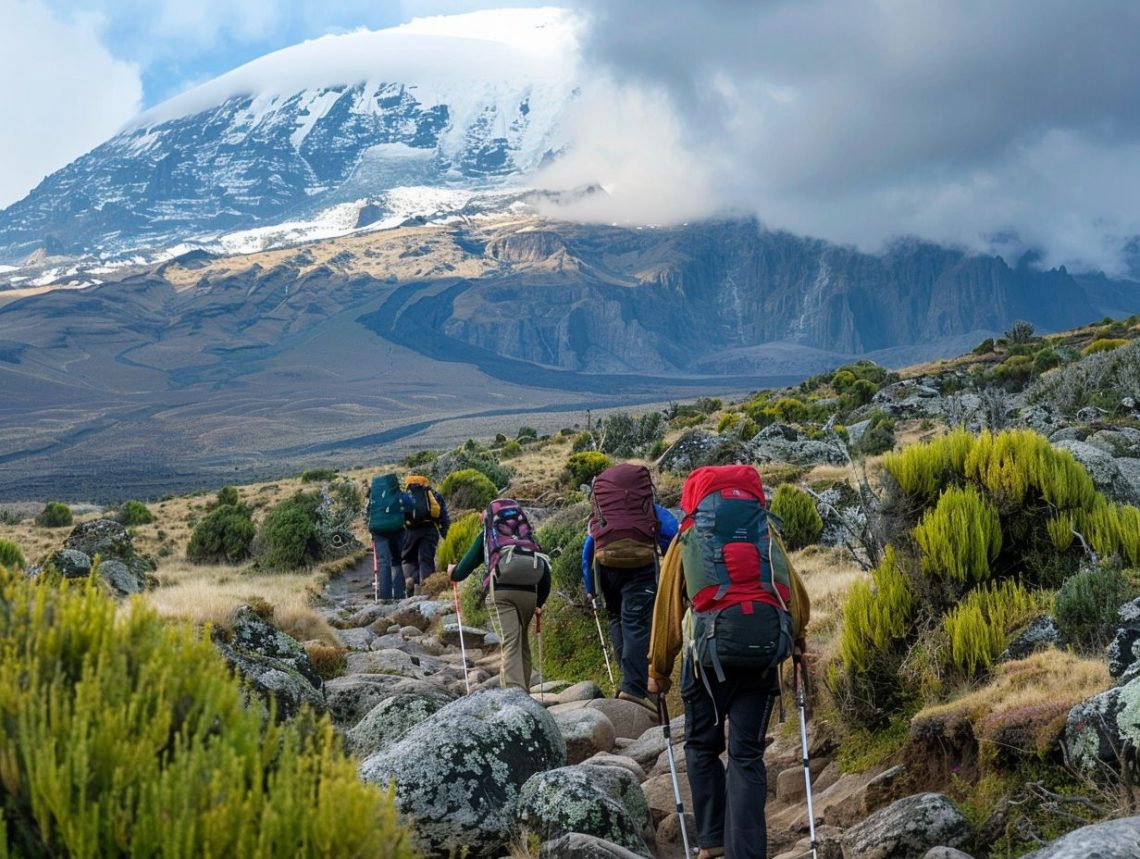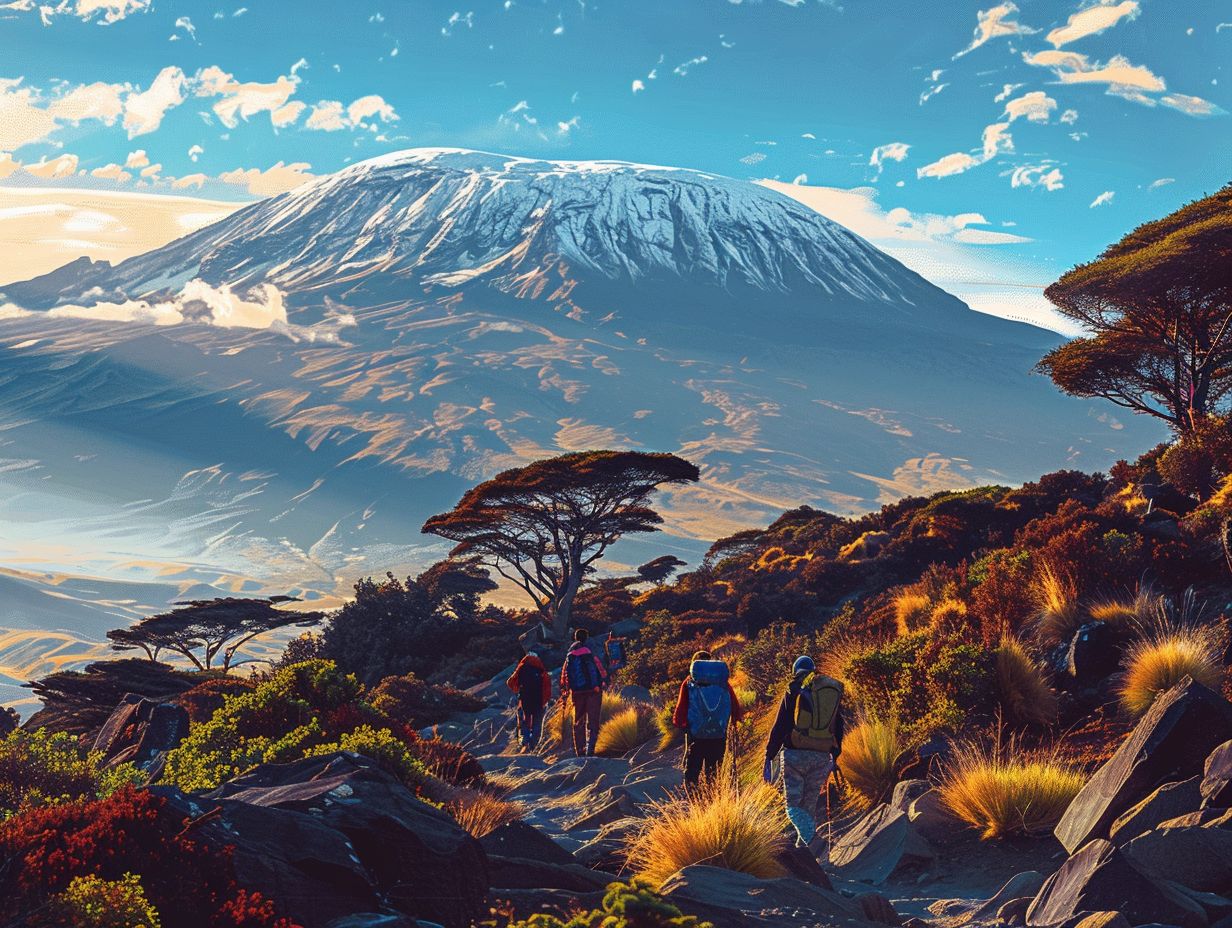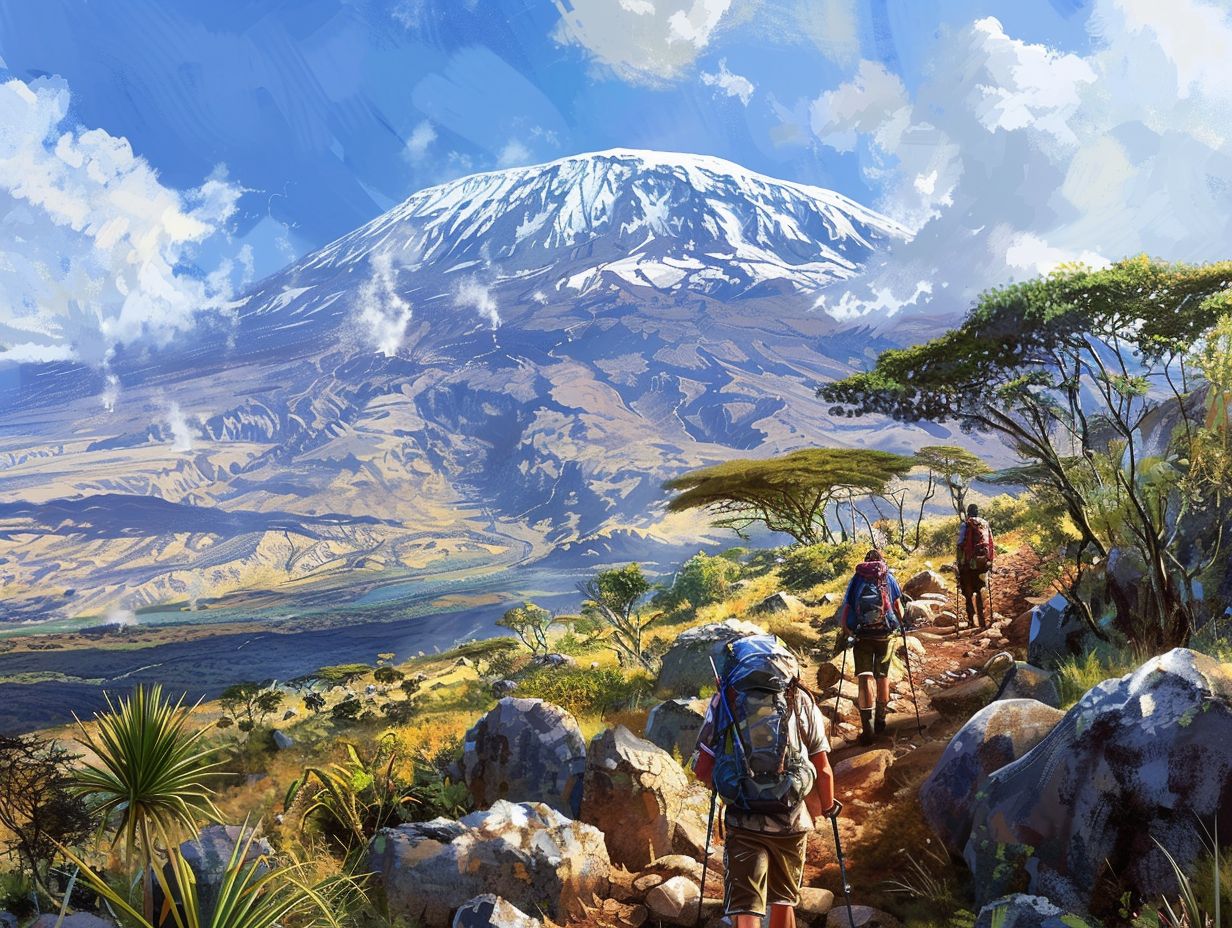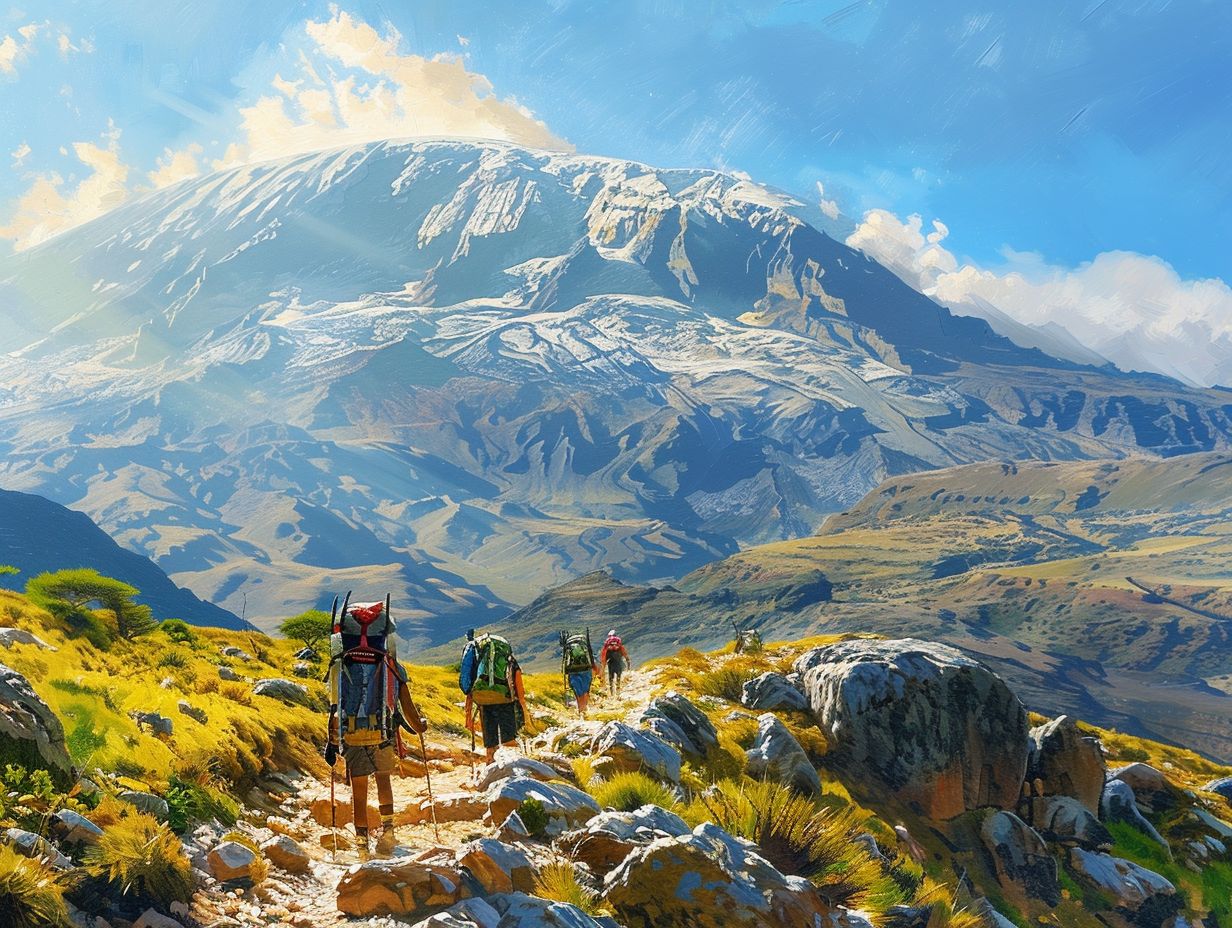
Climbing Kilimanjaro In October
Considering embarking on the adventure of a lifetime by climbing Kilimanjaro in October? This comprehensive article covers everything you need to know about this popular trekking month.
From the weather conditions to the crowds you can expect, the benefits and challenges of climbing in October, as well as tips for a successful climb, we have you covered.
Lace up your boots, pack your gear, and get ready for an unforgettable journey to the top of Africa’s highest peak.
Key Takeaways:

- October is a popular month for climbing Kilimanjaro due to favorable weather and less crowded trails.
- Climbing Kilimanjaro in October requires physical and mental preparation, as well as necessary gear and equipment.
- To have a successful climb in October, it is important to train, pack appropriate gear, and take necessary safety precautions.
Why October is a Popular Month for Climbing Kilimanjaro?
October is a favored month for climbing Kilimanjaro due to its favorable weather conditions, offering clear skies and excellent visibility. The presence of full moon climbs adds a mystical touch to the ascent.
The weather in October on Mount Kilimanjaro is characterized by moderate temperatures during the day and relatively warm nights, which can make the trek more comfortable compared to other months with extreme temperatures.
The clear skies and excellent visibility in October provide breathtaking panoramic views of the surrounding landscapes, allowing climbers to admire the stunning beauty of the African wilderness.
The full moon climbs in October not only illuminate the path but also contribute to improving the success rate of ascents, as the added light helps climbers navigate challenging sections more easily.
What is the Weather like in October?
The weather in October on Kilimanjaro is characterized by dry conditions, moderate temperatures, and minimal precipitation, creating ideal climbing conditions for adventurers.
In October, climbers on Kilimanjaro can anticipate clear skies and sunshine, providing breathtaking views of the surrounding landscapes.
The daytime temperatures generally range from 5 to 15 degrees Celsius, ensuring a comfortable ascent up the mountain. Due to the reduced rainfall during this period, the trails are usually drier and less slippery.
This favorable weather pattern in October attracts many hikers and mountaineers looking to conquer Africa’s highest peak.
What are the Crowds like in October?
October sees moderate crowds on Kilimanjaro, particularly in group climbs, necessitating adherence to safety precautions and coordination with fellow climbers for a smooth ascent.
Group climbs on Kilimanjaro in October create a fascinating dynamic where climbers from various backgrounds unite in pursuit of a shared goal.
Safety precautions such as staying hydrated, maintaining a steady pace, and listening to experienced guides become paramount in crowded conditions.
Effective coordination with other climbers boosts morale and enhances the overall climbing experience. Sharing experiences, offering support, and pooling resources can make the journey less arduous and more enjoyable.
What are the Benefits of Climbing Kilimanjaro in October?

Climbing Kilimanjaro in October offers enhanced visibility of the stunning Arctic zone and provides opportunities for mesmerizing star-gazing experiences due to the clear skies and full moon climbs.
During October, the sky above Kilimanjaro is a canvas sprinkled with a myriad of sparkling stars, creating a magical ambiance for climbers to admire nature’s celestial beauty.
The full moon climbs in this month add an extra layer of enchantment to the ascent, casting an ethereal glow over the landscape and illuminating the path. This unique experience of trekking under the gentle moonlight is unparalleled.
The unparalleled visibility of the Arctic zone during October allows climbers to witness breathtaking panoramic vistas stretching out before them.
The clear skies characteristic of this period provide unobstructed views of the surrounding landscapes, making every step upwards a feast for the eyes.
The contrast of the glacier-covered peaks against the night sky creates a mesmerizing scene that captivates climbers and leaves an indelible mark on their memories.
What are the Challenges of Climbing Kilimanjaro in October?
While October offers favorable conditions, climbing Kilimanjaro during this month poses challenges such as unpredictable weather forecasts, safety concerns, and the need for appropriate gear.
One of the primary challenges for climbers on Kilimanjaro in October is the constantly changing weather, which can range from sunny and warm to cold and snowy in a matter of hours.
This rapid shift in conditions requires climbers to be prepared with layers of clothing that can easily be adjusted.
In addition, the altitude and terrain of Kilimanjaro present safety hazards, making it crucial for climbers to acclimatize properly and have a knowledgeable guide leading the expedition.
What are the Physical Challenges?
The physical challenges of climbing Kilimanjaro in October include demanding trails, need for physical preparedness, and the endurance required to complete the ascent within the designated time and days.
October on Kilimanjaro brings rugged terrain, unpredictable weather, and slippery trails from occasional rainfall, posing unique challenges for climbers.
Physical training becomes crucial to build stamina and muscle strength for the arduous journey ahead. It is essential to acclimatize to the altitude and the thinning oxygen levels.
Meeting the time constraints becomes paramount, emphasizing the importance of pacing oneself effectively.
What are the Mental Challenges?
Mental challenges on Kilimanjaro in October revolve around coping with high altitudes, maintaining perseverance in the face of difficulties, and staying motivated throughout the demanding climb.
At high altitudes, climbers often experience symptoms of altitude sickness, such as headaches, nausea, and fatigue. It becomes crucial to listen to one’s body, hydrate adequately, and acclimatize properly.
Perseverance plays a key role in overcoming physical and mental barriers, those who successfully summit the peak often credit their determination and resilience as paramount in their achievement.
To maintain motivation during especially challenging segments, climbers often break down the climb into smaller, achievable goals, celebrating each milestone as they progress toward the summit.
What are the Gear and Equipment Challenges?
Gear challenges when climbing Kilimanjaro in October include ensuring summit gear is adequate, following safety precautions, and managing gear weight and functionality during the ascent.
Climbers gearing up for the daunting task of summiting Kilimanjaro in October must meticulously select their equipment to withstand the harsh conditions of the climb.
The altitude and unpredictable weather patterns demand specialized gear to ensure safety and comfort. Striking a balance between weight and functionality is crucial, as climbers need to be agile.
From high-quality waterproof jackets to insulated gloves, each piece of gear plays a vital role in the climber’s success. Adherence to safety measures such as proper footwear and headgear is paramount.
How to Prepare for Climbing Kilimanjaro in October?

Effective preparation for climbing Kilimanjaro in October involves dedicated training regimens, incorporating essential tips for success, and structuring a comprehensive schedule to optimize physical readiness and mental acuity.
When training for the Kilimanjaro climb, focus on cardio exercises such as hiking, running, and cycling to build endurance. Incorporate strength training to enhance muscle strength and stability, especially targeting leg muscles.
Proper nutrition plays a crucial role in fueling your body for the demanding trek, so ensure a balanced diet with sufficient proteins, carbohydrates, and hydration.
Mental preparedness is key, practice mindfulness and stress-relief techniques. Plan gradual altitude acclimatization through strategic timing of ascent and rest days in your itinerary.
What Training is Required?
Training for Kilimanjaro in October necessitates a focus on physical preparedness, stamina-building exercises, and acclimatization routines to increase the chances of a successful ascent.
Physical fitness is not just about endurance but also about strength and flexibility.
Climbers aiming to conquer Kilimanjaro should engage in a combination of cardiovascular activities like running, cycling, or hiking to build stamina and endurance for the long trek ahead.
Strength training focusing on leg muscles and core stability is crucial to withstand the rigorous demands of climbing.
What Gear and Equipment are Necessary?
Essential gear and equipment for Kilimanjaro in October include appropriate clothing layers, sturdy footwear, safety essentials, and gear tailored to the chosen route to ensure comfort, safety, and functionality.
Layering is key; pack moisture-wicking base layers, insulating mid-layers, and a waterproof outer shell to stay dry and warm amidst the varied climate zones.
Additionally, thermal socks and insulated gloves are essential to fend off the cold at higher altitudes. Safety gear such as a headlamp, trekking poles, and a first aid kit should also be in your backpack.
What are the Safety Precautions to Take?
Taking safety precautions while climbing Kilimanjaro in October involves meticulous planning, adherence to safety guidelines, and awareness of potential risks associated with off-season climb.
When embarking on a Kilimanjaro expedition during October, climbers must equip themselves with appropriate gear suitable for varying weather conditions.
It is imperative to stay hydrated at all times and acclimatize properly to prevent altitude sickness, a common concern on high-altitude climbs. Regular health check-ups are advised before and during the ascent.
Discussing emergency protocols and communication plans with the expedition team can greatly enhance safety measures.
What is the Cost of Climbing Kilimanjaro in October?
The cost of climbing Kilimanjaro in October varies based on factors such as travel arrangements, accommodation preferences, route selections, and additional vacation packages and booking considerations.
When planning your Kilimanjaro expedition in October, one of the primary cost components to consider is travel arrangements. Flights to Tanzania, the starting point for most climbers, can significantly impact the overall budget.
The choice of accommodation before and after the trek can vary from basic hostels to luxury lodges, affecting the total expenses. Route selections also play a crucial role.
For instance, the popular Marangu route may have different pricing compared to the Northern Circuit route, impacting the total cost of the expedition.
Vacation packages that include additional activities or services such as guides, porters, and meals can further influence the financial aspect of your journey.
What are the Tips for a Successful Climb in October?

To ensure a successful climb on Kilimanjaro in October, climbers should prioritize acclimatization, maintain hydration levels, leverage the benefits of clear visibility, and select suitable routes.
Acclimatization is crucial for climbers attempting Kilimanjaro as it helps the body adjust to the higher altitudes, reducing the risk of altitude sickness.
This process involves gradual ascent, allowing time for the body to adapt to lower oxygen levels. Ensuring adequate hydration is key to performance and health at high altitudes.
Taking advantage of clear visibility allows climbers to appreciate the stunning views and navigate more effectively. Careful route selection based on personal fitness and experience levels can enhance the overall climbing experience.
Frequently Asked Questions
1. When is the best time to climb Kilimanjaro?
A: October is considered one of the best months to climb Kilimanjaro due to the clear and dry weather conditions. However, the mountain can be climbed year-round, except during the rainy season in April and May.
2. What is the weather like when climbing Kilimanjaro in October?
A: October is known as one of the driest and warmest months to climb Kilimanjaro. The days are usually clear with mild temperatures, while the nights can get cold with temperatures dropping below freezing.
3. Are there any special preparations needed for climbing Kilimanjaro in October?
A: As with any climb, proper physical fitness and mental preparation are important. It is also recommended to bring appropriate gear for both warm and cold weather, as temperatures can vary. It is also important to acclimatize properly and stay hydrated during the climb.
4. Is October a popular month for climbing Kilimanjaro?
A: Yes, October is considered a popular month for climbing Kilimanjaro. This is due to the favorable weather conditions, making it a popular choice among climbers. It is recommended to book your climb in advance to secure a spot during this busy month.
5. Are there any dangers or risks associated with climbing Kilimanjaro in October?
A: While October is generally a safe time to climb Kilimanjaro, there are still risks and dangers associated with high altitude climbing. It is important to follow the guidance of experienced guides, acclimatize properly, and monitor your physical condition throughout the climb.
6. What is the difficulty level of climbing Kilimanjaro in October?
A: Climbing Kilimanjaro in October is considered moderate in terms of difficulty. The climb can range from 5-11 days depending on the route chosen, and it is recommended to have prior hiking and camping experience. Overall, with proper preparation and a good fitness level, it is achievable for most people.